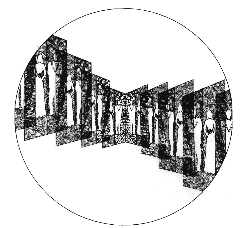Articles/Essays – Volume 12, No. 1
Nauvoo
I guess you could say that I’ve been a guest in my father’s house but have confined myself to one room. At any rate, that’s how I felt after visiting Nauvoo for the dedication of the Monument to Women.
Having been born Mormon, of pioneer (and yes, polygamous) stock, I felt fairly confident that I knew my heritage. Brigham Young had brought the Saints to the Salt Lake Valley, they settled in Utah, and that’s where my “Mecca” has been. Even though I grew up in the grassy hills of California, I have always felt an affirmation of my Mormon heritage when walking the ground of Temple Square. To me it was a homeland that years of relocation in California had deprived me of. I somehow belonged.
Perhaps that’s why Nauvoo was so unsettling. Having heard the songs of Zion sung by the waters of the Great Salt Lake, I was surprised to hear them sung by the Mississippi. But I did hear them, lightly on the Illinois wind, speaking to me of another heritage just as compelling as the pioneers I claimed in the West. They were the voices of over a hundred and thirty years ago, the voices of my spiritual forebears who had settled this lush bend in the river, a people of faith and tenacity, of hard work and strong belief. And a people who, in my mind, had never made the journey from hazy historical significance to reality.
I, who had somehow missed church history in seminary, recalled patchwork odds and ends about them, swatches of the relocation and sacrifice they experienced, of their persecution and durability. I was told that through it all they wore remarkably well, which made me more than slightly uneasy and disposed to settling them in a dusty corner of my mind where they would not be disturbed too often.
Nauvoo shook the dust off. I was confronted by them everywhere in that humid summer interim. Ostensibly, I was there to write some articles; actually, my sojourn was an introduction to my creditors.
The temple site was where I first had an inkling that Nauvoo’s first inhabitants were indeed real people, similar to the variety one might find whistling in the wind on a Utah day, or even anguishing in solitude over a child gone wrong. At first glance I saw only the excavated foundation of the temple, where once had stood a cleanly symmetrical building, deliberately cut from rock. Stone was cut less easily in the green town of 19th century Nauvoo than it is today; the task necessitated a commitment independent of cash pay-offs for those people. They had done it, had painstakingly carved and placed the sunstones, moonstones and starstones on the pilasters of the temple, in a temporal kind of obeisance. The people had reported each morning by the hundred to donate their labor. What was left was not merely rock.
I know that “common cause” is not peculiar to Mormon culture. We have no corner on working hard, working together. But I did feel, that muggy summer day, that these people had given totally to a conviction, an understanding that underpins my total existence. And a bonding occurred between us that grew stronger the more I walked the reconstructed town.
I visited the restored homes of the Nauvoo Saints—spare brick homes built to last, an optimistic indulgence of their plan to stay. But they were prepared to trade their reasonable degree of comfort for belief, if necessary, and as committees organized to force them from the state, they made good that commitment.
On a morning’s tour I walked down Mulholland Street, along which the bodies of Joseph and Hyrum had been transported from Carthage jail. The road was deserted; grasses lining each side lifted slightly as the breeze touched them.
To dance along dusty roads is easy when one has no knowledge of who has traveled them. To marvel at the sun skimming the river and the dragonflies drifting through the sultry afternoon is a luxury for the uninformed. But simplistic beauty pales beside visions of selflessness, even of those still grappling with their own inadequacies. That day I saw the people of a germinating Mormonism. I wanted to see myself as well.
The next evening a musical was performed, commemorating the women of the Church and their influence throughout generations. I waited until the crowds had scattered and then walked the Nauvoo night. The air was warm and musty and smelled of summer, and a few fireflies chased through the black air. Large leafy trees brushed the sky riveted with stars. I walked to the park, to the statues of Emma and Joseph. I touched them; the metal was hard, cold, tangible. And I knew that my days are carved from theirs, as others’ shall be of mine.


 Back to full Issue
Back to full Issue

